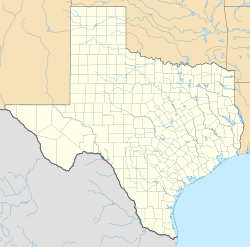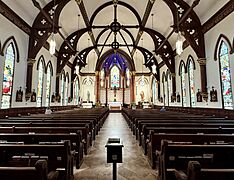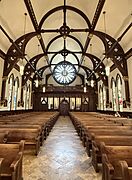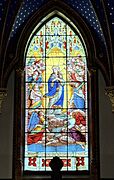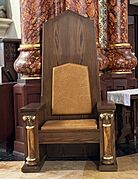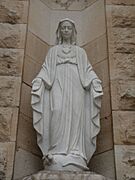Cathedral of Saint Mary (Austin, Texas) facts for kids
Quick facts for kids Saint Mary Cathedral |
|
|---|---|
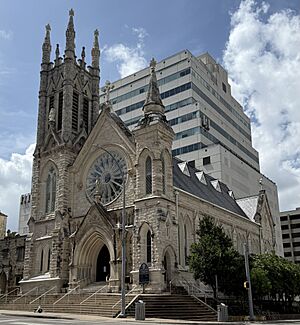
Saint Mary’s Cathedral in 2025
|
|
| 30°16′16″N 97°44′24″W / 30.27111°N 97.74000°W | |
| Location | 203 East 10th Street Austin, Texas |
| Country | United States |
| Denomination | Roman Catholic Church |
| History | |
| Status | Cathedral |
| Consecrated | 20 April 1884 |
| Architecture | |
| Functional status | Active |
| Architect(s) | Nicholas J. Clayton |
| Architectural type | Gothic Revival |
| Style | Gothic Revival |
| Groundbreaking | 1872 |
| Completed | 1884 |
| Specifications | |
| Materials | Limestone |
| Administration | |
| Diocese | Austin |
| Province | Galveston-Houston (Region X) |
Saint Mary's Cathedral is a very important church in Austin, Texas, United States. It is the main church for the Catholic Diocese of Austin. This beautiful building was added to the National Register of Historic Places in 1973. It is known for its amazing history and stunning design.
Contents
History of Saint Mary's Cathedral
Building a New Church in Austin
The story of Saint Mary's Cathedral began in the 1850s. At that time, many Irish Catholic families lived in Austin. They built a small stone church called St. Patrick's. It was located at 9th and Brazos Streets. The church was made from limestone found nearby.
More and more Catholic families, including many German Catholics, moved to Austin. The St. Patrick's church became too small. In 1866, the community decided to build a bigger church. They wanted a strong building made of stone.
Choosing a Name for the New Church
The Irish families wanted to keep the name St. Patrick. But the German families hoped for a saint that honored their background. They all agreed to a compromise. The new church would be named in honor of Mary.
In 1872, Austin became the permanent capital of Texas. The church community started building the new church. They chose a spot one block north of the old St. Patrick's church. At this time, Austin was part of the Diocese of Galveston.
From Parish Church to Cathedral
The new Saint Mary's church was finished in 1874. It was officially dedicated in 1884. The old St. Patrick's church was taken down around 1874.
In 1948, the Diocese of Austin was created. This meant that Saint Mary's became the main church, or cathedral, for the new diocese.
Celebrating Irish Roots
Saint Mary's Cathedral still remembers its Irish beginnings. Every Christmas, the Celtic Cultural Center of Texas holds a special concert there. It features traditional Irish and Scottish music. This concert is very popular and sells out every year.
Architecture and Design
The Cathedral's Unique Look
The new church was designed by an architect named Nicholas J. Clayton. He was born in Ireland. This was his first big project on his own. He designed the church in a Victorian style.
The tall towers and spires of the church were finished in 1907. They are built in a neo-Gothic Revival style. Some parts of the original design were removed in the 1950s. This might have happened after lightning struck the church.
Nature-Inspired Details
More beautiful stained-glass windows were added in the 1890s. The church's design is inspired by nature. The columns inside look like trees. They have carvings of leaves and plants. The paintings on the walls also show vines and leaves.
The pointed arches on the doors and windows, and the tall spires, remind people of mountains. The ceiling is blue and covered with stars. This makes it look like the sky and heavens.
The Giant Bell and Renovations
The cathedral has a very large bell. It was given by the family of Michael Butler. It is one of the biggest bells in Texas.
In 1948, the church was updated. Many of its old neo-Gothic decorations were taken out. The old altars were replaced with new marble ones. A special canopy over the altar was added. It has designs of cactus and bluebonnets, which are plants found in central Texas.
Restoration and the Rose Window
The cathedral had a big restoration project in 2013. This was done to fix some safety issues. Workers cleaned the outside of the building. They replaced some stone blocks and mortar.
They also restored the large rose window on the front of the church. The center of this window has a design called a quincunx. This is a pattern where four parts spin out from one central point. It can represent the four writers of the Gospels. It shows them spreading the Word to all parts of the world.
The building was officially listed on the National Register of Historic Places on April 2, 1973.
Cathedral School
The Cathedral School of Saint Mary was started in 1866. It is the oldest school in Austin that has been open continuously since it began.
Gallery
-
Statue of the Virgin Mary on the façade
See also
 In Spanish: Catedral de Santa María (Austin) para niños
In Spanish: Catedral de Santa María (Austin) para niños


